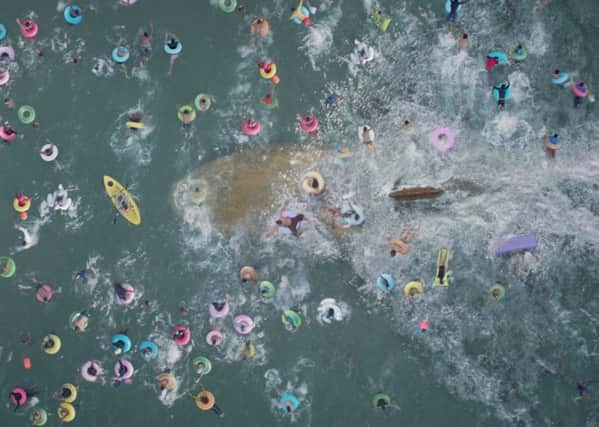Film reviews: The Meg | Leaning into the Wind: Andy Goldsworthy | The Negotiator | The Darkest Minds


The Meg (12A) ***
Leaning into the Wind: Andy Goldsworthy (PG) ****
The Negotiator (15) ***
The Darkest Minds (12A) **
The appeal of The Meg can be boiled down to the title-fight-style concept behind the posters currently adorning a bus stop near you: Jason Statham versus a giant prehistoric shark. As gleefully ridiculous as the notion of pitting the chrome-domed action star against a 27-metre shark previously believed to be extinct is, it’s a measure of Statham’s particular brand of self-aware machismo that it doesn’t feel like an unfair fight. One of the better things about The Meg, which is frequently as awful as it is endearingly silly, is that director Jon Turteltaub is fully aware of this and delivers plenty of shots of Statham going mano a mano with the titular megalodon – a word that Statham practically spits out during its first attack, his character, deep sea rescue diver Jonas Taylor, having previously encountered one during a compromised mission to save the crew of a damaged nuclear submarine. That botched operation has haunted him ever since, driving him to his current life as a barfly in Thailand. Redemptive storyline duly seeded (it’s not exactly the Indianapolis speech in Jaws, but still…), he’s brought back into the fray by an ex-colleague (Cliff Curtis) when a nearby underwater research project involving Taylor’s ex-wife (Jessica McNamee) is interrupted by some giant sea creatures. That’s just the first act, though. The film isn’t really interested in milking any tension from this particular scenario; it wants to get the shark (and Statham) in open water as quickly as possible and is pretty ruthless about cutting to the chase, sometimes to the point where entire scenes feel as if they’ve been chomped along with the supporting cast of one-dimensional racial and gender stereotypes brought in to give us nominal characters to care about. The problem when Statham isn’t involved in the action is that the film doesn’t know how to escape its own protective layer of tongue-in-cheek irony to deliver genuine thrills. As such, The Meg finds itself in the odd position of being a B-movie throwback at time when all blockbusters are essentially B-movies and genuine B-movies are made-for-cable trash fests like the Sharknado franchise. It can’t really compete with either so eventually gives up and turns into a fully fledged Jaws parody. Statham does make it watchable. But only just.
The ephemeral work of Scottish-based landscape artist Andy Goldsworthy makes film an ideal medium for documenting it. He makes sculptures from nature, but frequently lets nature reclaim them, sometimes the moment they’re completed. Leaning into the Wind captures this process beautifully. Whether he’s creating a shower of flower petals, making a living sculpture from a fallen tree, or lying on Edinburgh pavements in inclement weather to create one of his rain silhouettes, the film lets us see not just the finished work and the creative process behind it, but the way the art both alters and is altered by the surrounding landscape. Following Goldsworthy around the globe as he works on various commissions, what emerges from the film is a portrait of an artist who is less interested in leaving his mark on the world than he is in embracing the mark it leaves on him. Good work, he says, shouldn’t be a mystery but a moment of clarity amid the chaos of life, an idea summed up in the work that gives the film its title: a performative piece in which he takes to the rain-lashed British countryside and repeatedly tries to balance himself against a fierce headwind, enduring the repeated humiliation and pain of being blown over for those few seconds of transcendence when his body defies gravity. His other take home message resonates just as strongly: “Learning to fall is important.”
Advertisement
Hide AdHaving premiered at Sundance earlier this year as Beirut, the title change of political thriller The Negotiator feels appropriate for a movie that flirts with complexity but defaults to generic spy movie beats. Mostly set in 1982, the Tony Gilroy-scripted film stars Jon Hamm as Mason Skiles, an ex-American diplomat brought back into the fold to negotiate the release of a kidnapped CIA agent in the Lebanese capital. A decade earlier Mason had been living the high life in Beirut, where his detailed knowledge of Middle Eastern politics and his super-powered ability to talk made him an invaluable asset at a time when geopolitics was becoming ever sketchier. Ten years on and he’s a weary alcoholic drinking his life away to numb the pain of a personal tragedy. The soused middle-aged professional mourning his dead wife is hardly an original backstory in this sort of movie, but Hamm – playing Mason as a kind of gone-to-seed Don Draper – is so watchable he helps the film transcend its many eye-rolling clichés.
The Darkest Minds is the latest Hunger Games knock-off to get the big screen treatment – and the latest to offer another clunky and melodramatically rendered dystopian future where adolescents are maltreated by adults who fear them. This time it’s because of a virus that’s given the generation of children that have survived it X-Men-style mutant powers. The film follows 16-year-old mindreader Ruby (Amandla Stenberg) as she escapes an internment camp and falls in with a group of fellow teen outcasts searching for a rumoured save haven. Alas, like an extended TV pilot, the film is mostly a set-up for future instalments – instalments that will probably never get made thanks to its recent disastrous performance at the US box-office. ■